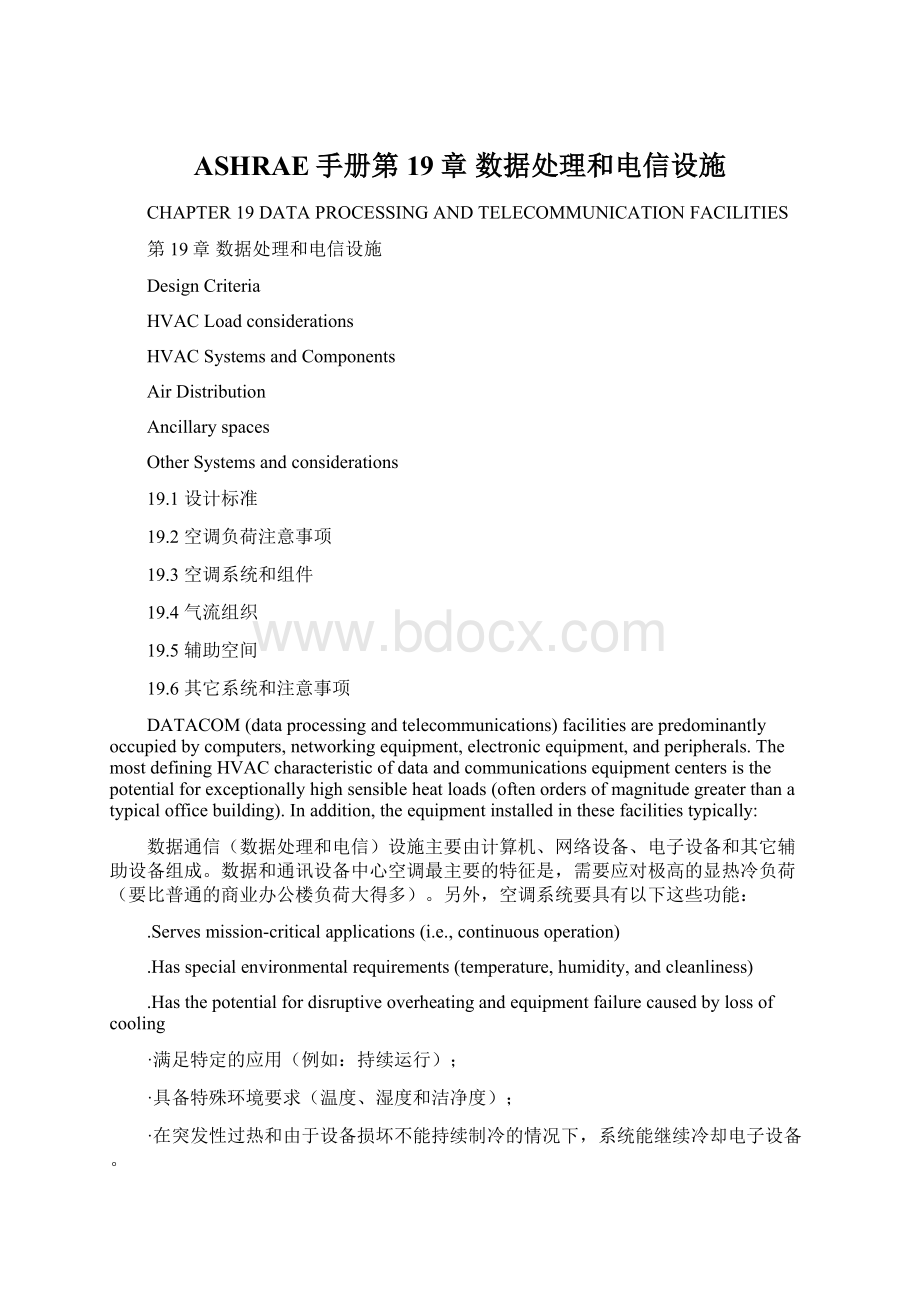ASHRAE手册第19章 数据处理和电信设施Word文件下载.docx
《ASHRAE手册第19章 数据处理和电信设施Word文件下载.docx》由会员分享,可在线阅读,更多相关《ASHRAE手册第19章 数据处理和电信设施Word文件下载.docx(41页珍藏版)》请在冰豆网上搜索。

19.6其它系统和注意事项
DATACOM(dataprocessingandtelecommunications)facilitiesarepredominantlyoccupiedbycomputers,networkingequipment,electronicequipment,andperipherals.ThemostdefiningHVACcharacteristicofdataandcommunicationsequipmentcentersisthepotentialforexceptionallyhighsensibleheatloads(oftenordersofmagnitudegreaterthanatypicalofficebuilding).Inaddition,theequipmentinstalledinthesefacilitiestypically:
数据通信(数据处理和电信)设施主要由计算机、网络设备、电子设备和其它辅助设备组成。
数据和通讯设备中心空调最主要的特征是,需要应对极高的显热冷负荷(要比普通的商业办公楼负荷大得多)。
另外,空调系统要具有以下这些功能:
.Servesmission-criticalapplications(i.e.,continuousoperation)
.Hasspecialenvironmentalrequirements(temperature,humidity,andcleanliness)
.Hasthepotentialfordisruptiveoverheatingandequipmentfailurecausedbylossofcooling
·
满足特定的应用(例如:
持续运行);
具备特殊环境要求(温度、湿度和洁净度);
在突发性过热和由于设备损坏不能持续制冷的情况下,系统能继续冷却电子设备。
Designofanydatacomfacilityshouldalsoaddressthefactthatmostdatacomequipmentwillbereplacedmultipletimeswithmorecurrenttechnologyduringthelifeofthefacility.AsdescribedinDatacomEquipmentPowerTrendsandCoolingapplications(ASHRAE2005a),typicaldatacomequipmentproductcyclesare1to5years,whereasfacilitiesandinfrastructureHAVClifecyclesof10to25years.Replacementequipmenthashistoricallyrequiredmoredemandingpowerandcoolingrequirements.
任何数据通信设施的设计时,都要面对这样一个事实:
在通信设施的使用寿命期间,随着技术的发展,大量现有的通信设备将会被将来的新设备更换掉。
在数据通信设备电源的发展过程和冷却应用中(ASHRAE2005a),典型的数据通讯设备产品寿命为1至5年,而空调设施和基础设施的寿命为10年至25年。
新设备对电功和制冷量要求的会更大。
Understandingthesecriticalparametersisessentialtodatacomfacilitydesign.
了解这些关键因素对数据通信设施的设计是必不可少的。
ThepreparationofthischapterisassignedtoTE9.9,Mission-criticalFacilities,TechnologySpaces,andElectronicEquipment.
由ASHRAE中负责“重要设施、工艺房间与电子设备”的技术委员会TC9.9编著。
Typesofdatacom(ASHRAE2005a)equipmentthatrequireairconditioningtomaintainproperenvironmentalconditionsinclude
数据通信中心(ASHRAE2005a)的空调系统的工作环境中,包含的数据通信设备类别有:
Computerservers(2Uandgreater)
Computerservers(1U,blade,andcustom)
Communication(High-density)
Communication(Extreme-density)
tapestorage
Storageservers
Workstations(standalone)
Otherrack-andcabinet-mountedequipment
服务器(2台或更多)
服务器(1台,black,andcustom)
通讯(高密度)
通讯(超高密度)
磁带存储器
存储服务器
工作站(独立)
其它机架和机柜安装设备
Personnelalsooccupydatacomfacilities,buttheiroccupancyistypicallytransientandenvironmentalconditions(e.g.,temperature,noise)aremoretypicallydictatedbyequipmentneeds.However,humanoccupancyinsmallerdatacomfacilitiesmayinfluencetheventilationairquantity.Adatacenterisabuildingorportionofabuildingwhoseprimaryfunctionistohouseacomputerroomanditssupportareas;
datacenterstypicallycontainhigh-endserversandstorageproductswithmission-criticalfunctions.Personnelalsooccupydatacomfacilities,buttheiroccupancyistypicallytransientandenvironmentalconditionsareusuallymoredictatedbyequipmentneeds,therebymakingitmoreofaprocesscoolingapplicationratherthancomfortcooling.However,humanoccupancyinsmallerdatacomfacilitiesmayinfluenceventilationairrequirements.
工作人员也占用数据通信中心,但其通常是暂时的,所以机房环境条件(如温度,噪音)常由设备的需求决定。
虽然工作人员占用的数据通信机房较小,但通风量也会受影响。
数据中心可能一个建筑物或建筑物的一部分,其主要功能是容纳一个计算机房和其他附属设施;
数据中心通常包含高端服务器和具有重要功能的存储设备。
工作人员也占用数据通信中心,但其通常是暂时的,所以机房环境条件(如温度,噪音)常由设备的需求决定,因此空调系统更多的是冷却功能而不是舒适功能。
虽然工作人员占用的数据通信机房较小,但对通风设计也会有要求。
Overview
19.1.1概述
Environmentalrequirementsofdatacomequipmentvarydependingonthetypeofequipmentand/ormanufacturer.However,aconsortiumofservermanufacturershasagreedonasetoffourstandardizedconditions(Classes1to4),listedinThermalGuidelinesforDataProcessingEnvironments(ASHRAE2008).Afifthclassification,theNetworkEquipment-BuildingSystems(NEBS)class,istypicallyusedintelecommunications.
不同类型的设备或制造商,他们的数据通信设备对环境的要求都有所不同。
然而,服务器制造厂家们达成了四个标准原则,此四条标准原则列于数据中心冷却指南(ThermalGuidelinesforDataProcessingEnvironmentsASHRAE2008)。
第五个分类,网络设备构建系统(NEBS)类,通常用于通信。
Class1:
typicallyadatacomfacilitywithtightlycontrolledenvironmentalparameters(dewpoint,temperature,andrelativehumidity)andmission-criticaloperations;
typesofproductstypicallydesignedfortheseenvironmentsareenterpriseserversandstorageproducts.
第一类:
通常数据通信设施有严格控制环境参数(露点,温度和相对湿度)和重要操作;
通信设备服务器和存储设备一般按照此条规定的环境参数设计。
Class2:
typicallyadatacomspaceorofficeorlabenvironmentwithsomecontrolofenvironmentalparameters(dewpoint,temperature,andrelativehumidity);
typesofproductstypicallydesignedforthisenvironmentaresmallservers,storageproducts,personalcomputers,andworkstations.
第二类:
通常数据通信机房或办公室或实验室环境中,会安装有环境参数控制设备(露点温度、温度和相对湿度);
小型服务器、存储设备、个人电脑和工作站一般按照此条规定的环境参数设计。
Class3:
typicallyanoffice,home,ortransportableenvironmentwithlittlecontrolofenvironmentalparameters(temperatureonly);
typesofproductstypicallydesignedforthisenvironmentarepersonalcomputers,workstations,laptops,andprinters.
第三类:
通常办公室、家庭或者运输环境只需要控制环境温度(温度);
个人电脑、工作站、笔记本电脑和打印机一般按照此条规定的环境参数设计。
Class4:
typicallyapoint-of-saleorlightindustrialorfactoryenvironmentwithweatherprotection,sufficientwinterheating,andventilation;
typesofproductstypicallydesignedforthisenvironmentarepoint-of-saleequipment,industrialcontrollers,orcomputersandhandheldelectronicssuchasPDAs.
第四类:
通常销售点或轻工业或工厂,需要有冬季采暖和通风条件。
设备销售点、工业控制器、计算机和手持式电子设备如掌上电脑(PDAs)一般按照此条规定的环境参数设计。
.NEBS:
perTelcordia(2001,2006),andtypicallyatelecommunicationscentralofficewithsomecontrolofenvironmentalparameters(dewpoint,temperatureandrelativehumidity);
typesofproductstypicallydesignedforthisenvironmentareswitches,transportequipment,androuters.
NEBS(网络设备构建系统):
根据Telcordia(2001,2006)规定,通常电信中心需要有环境控制装置(露点,温度和相对湿度);
交换机、传输设备和路由器一般按照此条规定的环境参数设计。
BecauseClass3and4environmentsarenotdesignedprimarilyfordatacomequipment,theyarenotcoveredfurtherinthischapter;
refertoASHRAE'
s(2008)ThermalGuidelinesforDataCenterenvironmentsforfurtherinformation.
由于第三和第四条不以数据通信设备为主,将不在下面章节中讨论。
如想了解更多信息请参考数据中心冷却指南(ThermalGuidelinesforDataProcessingEnvironmentsASHRAE2008)。
EnvironmentalSpecifications
19.1.2环境说明
Table1listsrecommendandallowableconditionsforClass1,Class2,andNEBSenvironments,asdefinedbythefootnotedsources.Figure1Ashowsrecommendedtemperatureandhumidityconditionsfortheseclassesonapsychrometricchart,andFigure1Bshowsallowabletemperatureandhumidityconditions.Notethatdew-pointtemperatureandrelativehumidityarealsospecified.
表1列出了一类、二类和NEBS的建议和允许环境要求,详细介绍见脚注。
图1A中,在焓湿图上给出了这两类推荐的环境要求;
图1B中,在焓湿图上给出了这两类允许的环境要求。
请注意,露点温度和相对湿度也已给出。
图1A数据中心Class1、Class2和NEBS推荐的环境参数
表1数据中心Class1、Class2和NEBS设计参数
a.InletconditionsrecommendedinASHRAE(2008).
a.ASHRAE(2008)推荐送风温度;
b.PercentagevaluesperASHRAEStandard52.1dustspotefficiencytest.MERVvaluesperASHRAEStandard52.2
b.平均值按照ASHRAE标准52.1除尘点效率测试,MERV(MinimumEfficiencyReportingValue)值按照ASHRAE标准52.2
c.Telcordia(2006).
d.Telcordia(2001).
e.Generallyacceptedtelecommunicationspractice.Telecommunicationscentralofficesarenotgenerallyhumidified,butpersonnelareoftengroundedtoreduceelectrostaticdischarge(ESD)
e.通信行业常规做法。
通信中心通常不需要加湿,但人员需要经常接地,以减少静电放电(ESD,Electro-Staticdischarge)
f.SeeFigure2fortemperaturederatingwithaltitude
f.见图2温度梯级
Airdensityalsoaffectstheabilityofdatacomequipmenttobeadequatelycooled.ASHRAE'
s(2008)ThermalGuidelinesforDataProcessingEnvironmentssuggeststhatdatacenterproductsbedesignedtooperateupto3050maltitude,butrecognizesthatthereisreducedmassflowandconvectiveheattransferassociatedwithlowerairdensityathigherelevations.Toaccountforthiseffect,theguidelineincludesaderatingchartforthemaximumallowabletemperatureof1Kper300maltitudeabove900m(Classes1to4).Figure2showsthealtitudederatingrecommendedbyASHRAE(2004)forClasses1and2,andforNEBS.
空气的密度也会影响数据通信设备的冷却效果。
ASHRAE(2008)数据中心冷却指南(ThermalGuidelinesforDataProcessingEnvironmentsASHRAE2008)指出,数据中心设备工作环境的海拔高度不要超过3050m,同时也指出,随着海拔高度的增加,空气的密度逐渐降低,对空气的质量流量和设备的对流换热有一定的影响。
考虑到这些因素,数据中心冷却指南给出了一张阶梯图,在海拔900m以上,每升高300m,设备的最大允许温度下降1℃(1至4类)。
ASHRAE(2004)给出,随着海拔高度的增加1类、2类和NEBS的工作环境温度范围。
Thestatedenvironmentalconditionsareasmeasuredattheinlettothedataandcommunicationsequipment,andnotaveragespaceorreturnairconditions.
规定的测试条件是:
以数据通信设备的进口作为参考点,而不是机房内平均温度或者回风温度。
Temperature
19.1.3温度
Theallowabletemperaturerangeisastatementoffunctionality,whereastherecommendedrangeisastatementofreliability.Thus,equipmentexposedtoprolongedhightemperatures(and/ortosteeptemperaturegradients)canexperienceincreasedfailurerates,reducedservicelife,hardwareand/orsoftwarefailures,and/orthermalshutdown.Exceedingtherecommendedlimitsforshortperiodsoftimeshouldnotbeaproblem,butrunningneartheallowablelimitsformonthscouldresultinincreasedreliabilityissues.Facilitydesignersandoperatorsshouldstriveforcontinuousoperationintherecommendedrange.ASHRAE(2008)andTelcordia(2001)recommendedrangeis18to27℃.
尽管建议的设备的允许温度范围是可靠的,但它只是一个功能说明。
因此,当设备长期暴露在高温环境下(温度波动频率或幅度大),就会提高设备的故障率,降低设备使用寿命,硬件/软件故障率提高,传热性能下降。
短时间超过允许温度范围不会对设备造成影响,但如果几个月一直在接近温度范围边界运行,设备的上述问题出现的概率会提高。
设计师和管理者都应该努力使设备在允许温度区间内运行。
ASHRAE(2008)和Telcordia(2001)推荐的温度范围是18℃到27℃。
Fig.1BAllowableDataCenterClass1,Class2,andNEBSOperatingCondit